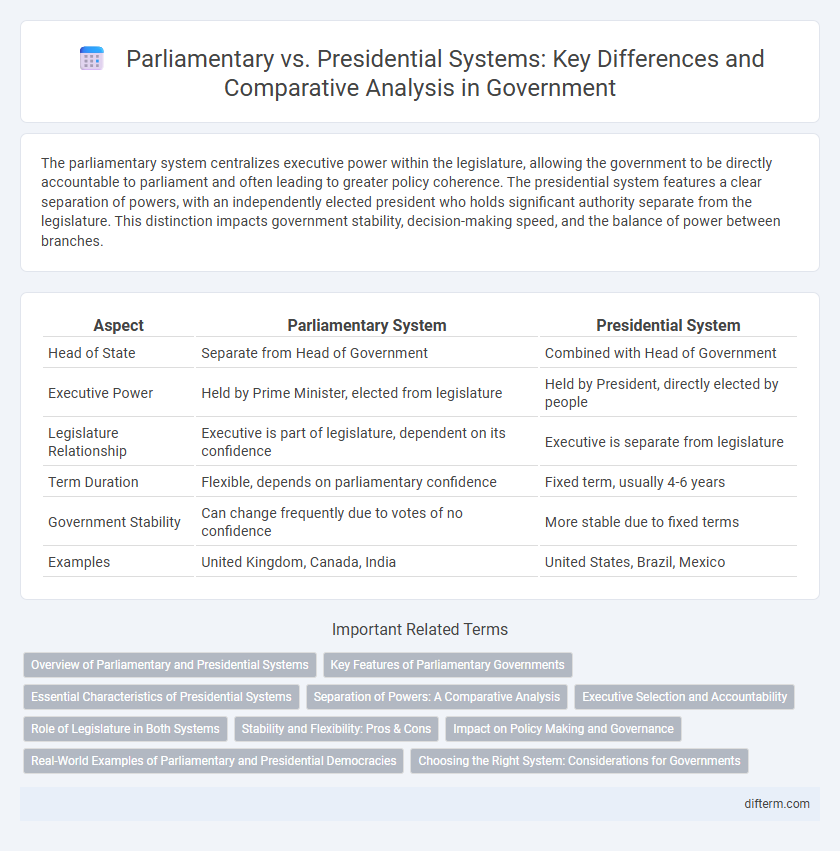The parliamentary system centralizes executive power within the legislature, allowing the government to be directly accountable to parliament and often leading to greater policy coherence. The presidential system features a clear separation of powers, with an independently elected president who holds significant authority separate from the legislature. This distinction impacts government stability, decision-making speed, and the balance of power between branches.
Table of Comparison
| Aspect | Parliamentary System | Presidential System |
|---|---|---|
| Head of State | Separate from Head of Government | Combined with Head of Government |
| Executive Power | Held by Prime Minister, elected from legislature | Held by President, directly elected by people |
| Legislature Relationship | Executive is part of legislature, dependent on its confidence | Executive is separate from legislature |
| Term Duration | Flexible, depends on parliamentary confidence | Fixed term, usually 4-6 years |
| Government Stability | Can change frequently due to votes of no confidence | More stable due to fixed terms |
| Examples | United Kingdom, Canada, India | United States, Brazil, Mexico |
Overview of Parliamentary and Presidential Systems
Parliamentary systems feature a fusion of executive and legislative branches, where the prime minister is typically a member of the legislature and relies on parliamentary confidence, enabling more cohesive policy-making and quicker legislative approval. Presidential systems separate executive and legislative powers, with a directly elected president serving as head of state and government, promoting checks and balances but often leading to divided government and legislative gridlock. Both systems impact governance efficiency, political stability, and accountability, influencing how laws are passed and executives respond to public mandates.
Key Features of Parliamentary Governments
Parliamentary governments are characterized by a fusion of executive and legislative powers, where the prime minister and cabinet are drawn from the elected legislature, ensuring accountability through continuous parliamentary confidence. The executive branch is directly dependent on the legislature for its legitimacy, allowing for more flexible and responsive governance, often leading to quicker policy implementation. This system typically features a ceremonial head of state with limited powers while the prime minister acts as the head of government, centralizing political leadership within the parliament.
Essential Characteristics of Presidential Systems
Presidential systems are characterized by a clear separation of powers between the executive and legislative branches, with the president serving as both head of state and government. The president is elected independently of the legislature, usually through a direct popular vote, and holds significant decision-making authority, including veto power and command over the armed forces. Fixed terms for the president provide stability and prevent legislative interference, fostering a system of checks and balances unique to presidential governance.
Separation of Powers: A Comparative Analysis
Parliamentary systems concentrate executive and legislative powers by merging roles, where the prime minister is typically a member of the legislature and accountable to it, promoting unified government. Presidential systems enforce a stricter separation of powers by constitutionally dividing the executive, legislative, and judicial branches, with the president independently elected and serving fixed terms. This division in presidential systems often results in checks and balances designed to prevent any branch from gaining excessive control, contrasting with the fused powers seen in parliamentary systems.
Executive Selection and Accountability
In parliamentary systems, the executive is selected from the legislature, typically the majority party, ensuring direct accountability to the parliament and enabling easier removal through votes of no confidence. Conversely, presidential systems feature a separately elected executive, providing a fixed term and clearer separation of powers but often reducing legislative control over executive accountability. This difference impacts government stability and the balance of power between branches.
Role of Legislature in Both Systems
The legislature in a parliamentary system holds significant power in forming and sustaining the government by selecting the prime minister and approving cabinet members, ensuring executive accountability. In contrast, a presidential system separates executive and legislative powers, with the legislature primarily responsible for lawmaking and budget approval, while the president independently manages government operations. This division in presidential systems creates a system of checks and balances, whereas parliamentary systems emphasize executive-legislative collaboration.
Stability and Flexibility: Pros & Cons
Parliamentary systems often provide greater flexibility and quicker policy responses due to the fusion of executive and legislative branches, enhancing government adaptability. However, this can lead to less stability, as frequent votes of no confidence may trigger government collapses and elections. Presidential systems offer more stability through fixed terms and separation of powers, but this rigidity can result in policy gridlock and slower responses during crises.
Impact on Policy Making and Governance
Parliamentary systems centralize policy making within the legislature, enabling faster enactment of laws due to the executive's dependence on parliamentary confidence, which enhances governmental cohesion and accountability. Presidential systems separate executive and legislative powers, potentially causing policy gridlock but allowing for greater checks and balances through independent branches. The choice between parliamentary and presidential governance profoundly influences the efficiency, stability, and responsiveness of policy formulation and implementation.
Real-World Examples of Parliamentary and Presidential Democracies
The United Kingdom exemplifies a parliamentary democracy where the Prime Minister leads the government, while the executive power is derived from the legislative branch. In contrast, the United States operates a presidential democracy with a separately elected President who serves as both head of state and government, ensuring a clear separation of powers. Other notable examples include India as a parliamentary system and Brazil as a presidential system, each illustrating distinct mechanisms of governance and executive-legislative relations.
Choosing the Right System: Considerations for Governments
Parliamentary systems offer greater legislative-executive integration, enhancing policy coherence and quicker lawmaking, while presidential systems emphasize separation of powers, promoting checks and balances and preventing authoritarianism. Governments must evaluate factors such as political stability, historical context, party dynamics, and public accountability when choosing between these models. Effective governance depends on aligning the system with national social structures, institutional capacities, and democratic values to optimize efficiency and representation.
Parliamentary vs Presidential Infographic

 difterm.com
difterm.com